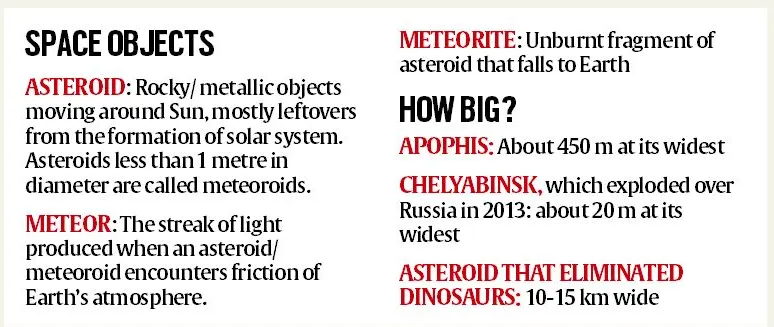Note4Students
From UPSC perspective, the following things are important :
Prelims level: Space Objects
Mains level: Challenges related to asteroid Apophis
Why in the news?
Last week, ISRO Chairman S Somanath expressed the possibility of engaging with the asteroid Apophis during its close approach to Earth at a distance of 32,000 km in 2029. However, the specific manner of ISRO’s involvement has not yet been determined.
Space objects:

The asteroid Apophis may pose a threat:
- Initial Concerns: Discovered in 2004, Apophis initially posed a 2.7% chance of colliding with Earth, raising alarms due to its size (about 450 m wide).
- Revised Risk: Subsequent observations ruled out immediate collision risks in 2029, 2036, and 2068, but it will pass close to Earth in 2029 at 32,000 km.
- Potential Impact: Its size could cause significant damage if it were to collide with Earth, though recent observations suggest no imminent danger.
Other possible incoming threats from space:
- Daily Encounters: Thousands of asteroids enter Earth’s atmosphere daily, most burning up due to friction, causing phenomena like fireballs.
- Russian Example: In 2013, a 20-meter asteroid exploded above Russia, releasing significant energy and causing damage and injuries.
- Detection Challenges: Some asteroids are detected only upon entering the atmosphere, especially those coming from the direction of the Sun, which can obscure detection.
ISRO’s plan: From sci-fi to reality:
- Planetary Defense Initiative: ISRO aims to develop capabilities in planetary defense, potentially participating in missions to study and potentially deflect asteroids.
- Collaboration: Considering sending its own spacecraft or collaborating with other space agencies, like NASA, which has already redirected a spacecraft to study Apophis in 2029.
- Evolution of ISRO: Reflects ISRO’s evolution as a space agency, transitioning from aspirations to reality in tackling global space objectives, demonstrating growing confidence and capabilities.
Way forward:
- Form Partnerships: ISRO should actively seek partnerships with leading space agencies like NASA, ESA (European Space Agency), and others involved in asteroid detection and planetary defense.
- Joint Missions: Collaborate on joint missions to study and potentially mitigate asteroid threats. This could include sharing resources, technology, and expertise to maximize effectiveness and minimize costs.
Mains PYQ:
Q What is India’s plan to have its own space station and how will it benefit our space programme? (UPSC IAS/2019)
Get an IAS/IPS ranker as your 1: 1 personal mentor for UPSC 2024

